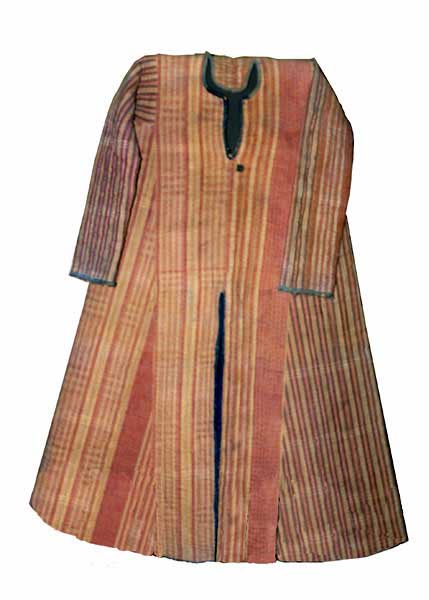Difference between revisions of "Quilted Cloth (V7)"
From AmtWiki
| Line 1: | Line 1: | ||
===An [[Armor]]=== | ===An [[Armor]]=== | ||
| − | ====According to the [[Rulebook]]==== [[Image:1919.29.7.jpg|thumb|This long, quilted coat is known as a jibbah. It was worn by an Ansar, a Sufi Muslim warrior and follower of El Mahdi, in northern Sudan in the late 19th century. The split down the front enabled it to be worn both on horseback and on foot. Muslim Europeans would have worn it under mail but in the Sudan and Nigeria it was often worn alone. It is made from cotton called dammur, spun by women and woven by men. This jibbah has a more complex and colourful woven pattern than most, the conventionally vertical and horizontal quilting lines spaced 1-3 cm apart.]] | + | ====According to the [[Rulebook]]==== |
| + | [[Image:1919.29.7.jpg|thumb|This long, quilted coat is known as a jibbah. It was worn by an Ansar, a Sufi Muslim warrior and follower of El Mahdi, in northern Sudan in the late 19th century. The split down the front enabled it to be worn both on horseback and on foot. Muslim Europeans would have worn it under mail but in the Sudan and Nigeria it was often worn alone. It is made from cotton called dammur, spun by women and woven by men. This jibbah has a more complex and colourful woven pattern than most, the conventionally vertical and horizontal quilting lines spaced 1-3 cm apart.]] | ||
"Two layers of cloth with padding in between sewn together." | "Two layers of cloth with padding in between sewn together." | ||
[[Category:Rulebook Terms]] | [[Category:Rulebook Terms]] | ||
Revision as of 04:41, 12 November 2008
An Armor
According to the Rulebook

This long, quilted coat is known as a jibbah. It was worn by an Ansar, a Sufi Muslim warrior and follower of El Mahdi, in northern Sudan in the late 19th century. The split down the front enabled it to be worn both on horseback and on foot. Muslim Europeans would have worn it under mail but in the Sudan and Nigeria it was often worn alone. It is made from cotton called dammur, spun by women and woven by men. This jibbah has a more complex and colourful woven pattern than most, the conventionally vertical and horizontal quilting lines spaced 1-3 cm apart.
"Two layers of cloth with padding in between sewn together."